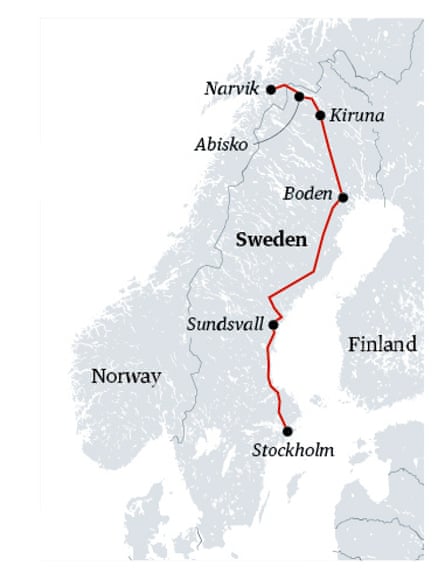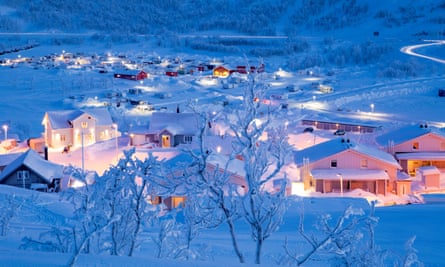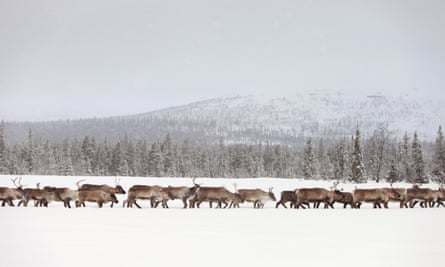
As train adventures go, the journey from Stockholm to Narvik, the northernmost railway station in western Europe, has to be one of the world’s most epic. Our final destination, however, is Abisko, a couple of stops before Narvik and still in Sweden.
Even the name, the Arctic Circle train, sounds intrepid, like a gritty start to a fearless expedition into uncharted territory.
But it was nothing of the sort. Far from being off the beaten track, the Arctic Circle train was packed on the winter evening we took it, with passengers in down jackets heading to the frozen north in search of reindeer, moose and the northern lights. Fears that I had dragged my teenage daughter Mathilde on the equivalent of a polar package tour proved unfounded. Most of the travellers who occupied the seats and berths on the VY Nattåg D94 sleeper train at Stockholm at 6.10pm the evening before melted away the further north we went. By 11.07am the next day, when we pulled into snow-covered Abisko 600 miles north, only a handful of us stepped off the train into the silent Narnia-like landscape.
After Abisko, the Arctic Circle train continues onwards to Riksgränsen on the Norwegian border and then west to its final stop at Narvik in Norway, arriving at 12.35.
Online, the Abisko Turiststation – a hotel run by the Swedish Tourist Association – seemed as heavily booked as the train, but when we set off the next morning for a hike to nearby Lake Torneträsk, a 128-square-mile stretch of partially frozen water, we encountered nobody. The snow was deep, crisp, even and without any other footprints.

It was a last-minute booking, so the first-class sleeping berths with toilet and shower were sold out, as were the second-class couchettes. Our 11th-hour options came down to two beds in a six-berth couchette, a three-berth second-class private compartment or reclining seats. We booked the former and I nabbed the middle two, the only ones with a full view from the window. I left the blind up to watch the arcing overhead electric lines light up the trackside as we journeyed north.
The carriages are not new and you could not swing a kitten, let alone a cat, in them. There was around two square metres of floor space, not counting the seat/bunks – a squeeze for three people never mind six. But it was clean and warm, with crisp cotton sheets, quilts and decent pillows, and the beds were comfortable. Our compartment had a small sink, electric sockets and wifi. The toilet and shower at the end of each carriage remained remarkably clean throughout the long journey, though the toilet paper had run out by the following morning.

The journey to the Sápmi region – better known as Lapland and spanning the top of Sweden, Norway and Finland and home to the nomadic Sámi and their reindeer herds – runs three-quarters of the length of Sweden, first along the east coast until it joins the mainline through Upper Norrland from Umeå to Boden. It then follows the Iron Ore line, crossing Swedish Lapland and stopping at the mining towns of Gällivare and Kiruna.
The Iron Ore line was down to a single track by the time we reached Abisko. It was built between the late 1800s and early 1900s to transport iron ore to the ports of Luleå on Sweden’s east coast and to the ice-free harbour in Narvik. During its construction, the crews – known as rallare – created small communities along the line as they extended it.
Although the sun does not rise above the horizon in the Arctic Circle for several weeks in winter, there are a few hours of daylight, as well as what locals call kaamos, a natural light phenomenon that creates a “blue moment” for about 15 minutes around 2pm before darkness begins to fall.
The view from the train as it rattled through the countryside was of a vast snow-covered landscape of valleys, mountains and lakes, of birch and pine trees and the occasional wooden house in the middle of nowhere.
The Norwegian Railways magazine in our carriage promised passengers they would “travel with your nose squashed on the window, enchanted by the wonder of the landscape”, though the enchantment would have been improved with cleaner windows.
after newsletter promotion

Before we’d left Stockholm, Vy, the Norwegian railway company, had sent a text message saying dining facilities would be limited, but I did find a serving hatch where the attendant told me that the company had a shortage of dining cars and preferred to use them on trains in the opposite direction.
She pointed to a menu offering a decent selection, including reindeer stew, lasagne and grilled chicken for 119 kronor (£9) each, and snacks of moose or reindeer salami for 35 kronor, as well hot and cold drinks. There was also a selection marked “for a nicer journey”, with pastries, sweets, earplugs, a stuffed toy reindeer and a deck of cards.
The next morning, many passengers descended at Kiruna, Sweden’s northernmost city, founded in 1900 – and said to be the world’s largest city in area. Its modern-day claim to fame is that it is being moved building by building to a new downtown district two miles to the east because of the subsidence risk from the iron ore mine beneath it. Some buildings are being dismantled and rebuilt; others are being literally picked up, placed on lorries and trundled to their new location.
The pretty countryside around the town is dotted with villages that showcase Sámi culture, and the Jukkasjärvi Icehotel is a few miles to the east (we later went mushing there with husky sleds).

We stayed on the train as far as Abisko, which has two stations: one in the village, where there is a hotel, a handful of guesthouses and hostels and a supermarket, and a second serving the Abisko Turiststation.
The Swedes claim Abisko, with its “blue hole” – a cloud gap directly above Abisko national park – is the best place on Earth to see the aurora borealis. We booked a chilly 30-minute chairlift ride up Mount Nuolja to the Aurora Sky Station, more in hope than expectation. A couple of disappointed visitors leaving as we arrived told us it had been too cloudy and they had seen nothing during their stay.
In the event, we need not have bothered with the chairlift. As we stomped through the snow towards it, the sky began to dance with white, pale green and purple-tinged lights swirling overhead and rocketing in rays upwards. “Look, look,” said our guide, who must have seen them a thousand times but seemed as excited as we were. “Look … the aurora.”
The Arctic Circle train is included in Interrail and Eurail passes, though those travelling from Narvik to Stockholm will need an Interrail global pass. Advance booking recommended as seats/berths on the sleeper trains can sell out quickly



